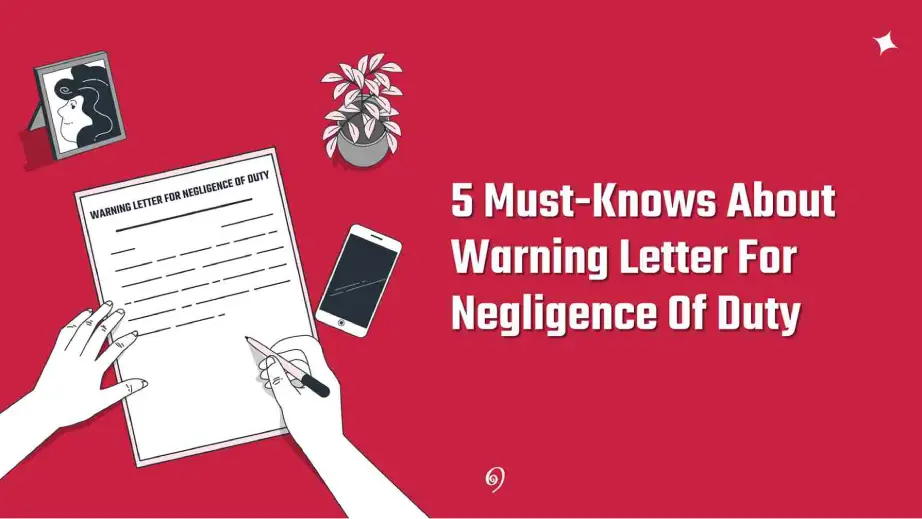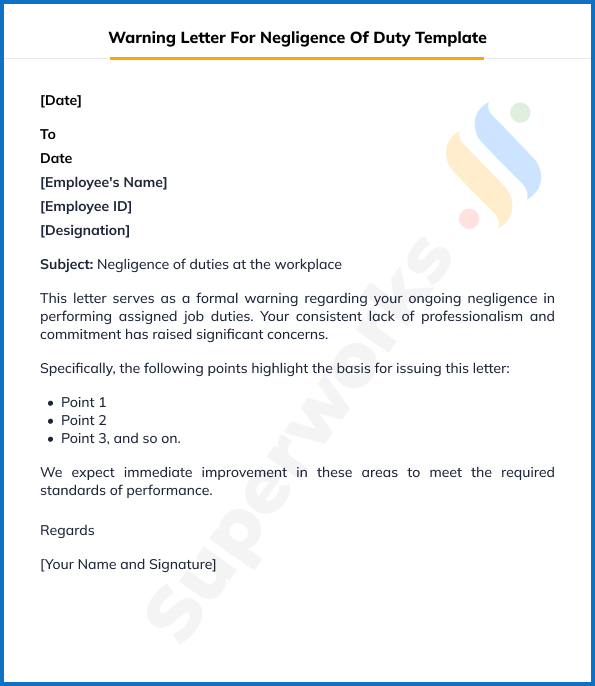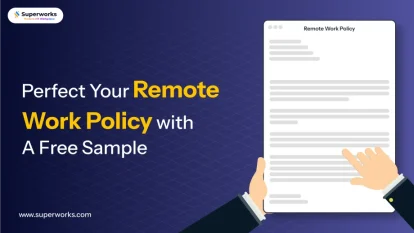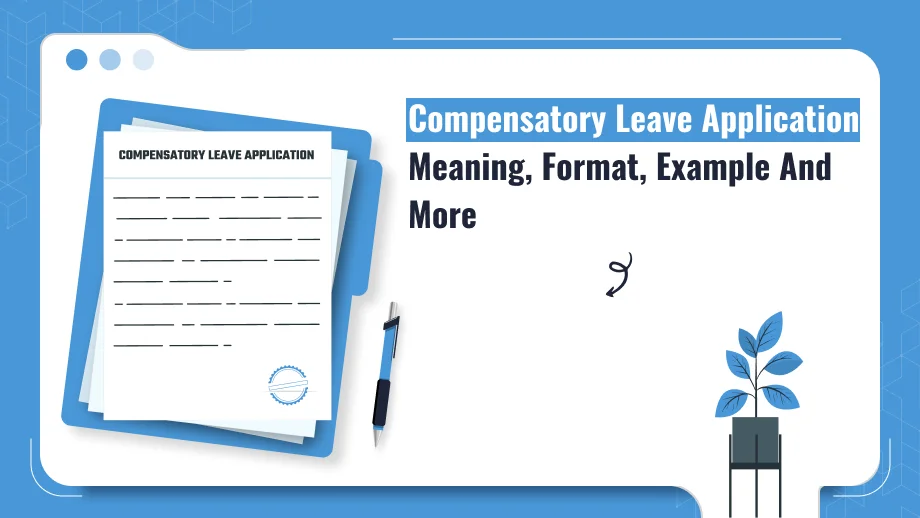Grab a chance to avail 6 Months of Performance Module for FREE
Book a free demo session & learn more about it!
-
Will customized solution for your needs
-
Empowering users with user-friendly features
-
Driving success across diverse industries, everywhere.
Grab a chance to avail 6 Months of Performance Module for FREE
Book a free demo session & learn more about it!
Superworks
Modern HR Workplace
Your Partner in the entire Employee Life Cycle
From recruitment to retirement manage every stage of employee lifecycle with ease.


Seamless onboarding & offboarding
Automated compliance & payroll
Track performance & engagement
5 Must-Knows About Warning Letter For Negligence Of Duty
- warning letter to employee for negligence
- 13 min read
- July 24, 2023

Are you aware of the potential consequences that come with receiving a warning letter for negligence of duty?
Negligence can have far-reaching impacts, not only on an employee’s professional reputation but it also makes employee management extremely difficult for HR professionals. In this blog, we will explore five crucial facts about warning letters for the negligence of duty.
From understanding the severity of the situation to the legal implications, we will delve into the intricacies surrounding this issue. Whether you are an employee striving to avoid negligence or an employer concerned about enforcing accountability, this article will equip you with the essential knowledge to navigate these challenging waters effectively. We will also provide you with a warning letter format.
Note:You can download directly from here and edit as per your need.
- Understanding a Warning Letter For Negligence Of Duty
- 6 Benefits of a Warning Letter For Negligence Of Duty
- 5 Reasons to Issue a Warning Letter for Negligence
- Basic Elements a Warning Letter for Negligence of Duty Must Have
- 6 Things to Keep in Mind While Drafting a Warning Letter for Negligence
- A Warning Letter For Negligence Of Duty Template
- Bottom Line
Understanding a Warning Letter For Negligence Of Duty
A warning letter for negligence of duty, also known as an employee warning letter is a formal document issued by an employer to an employee who has displayed a consistent lack of responsibility or failure to fulfill their assigned tasks and responsibilities. It serves as a written reprimand, highlighting the employee’s negligence and its negative impact on the organization.
An employee warning letter, be it a warning letter for not performing duty or coming late, outlines specific instances of negligence, explains the expected standards of performance, and warns of potential consequences if improvements are not made. This disciplinary action is aimed at addressing the employee’s behavior, rectifying the situation, and ensuring future compliance with the organization’s policies and expectations.
6 Benefits of a Warning Letter For Negligence Of Duty
Here are six benefits of issuing a warning letter for negligence of duty:
1. Clear Communication:

A warning letter serves as a crucial means of clear communication between the employer and the employee. It provides an official and documented notice to the employee that their performance or conduct has been unsatisfactory, specifically addressing instances of negligence of duty.
By putting the concerns in writing, the employer ensures that there is no ambiguity or misunderstanding regarding the employee’s shortcomings. This direct communication helps the employee understand the gravity of their actions and the need for improvement.
Additionally, it establishes a clear record of the employer’s expectations, making it easier to reference and discuss the issues during any subsequent conversations or evaluations.
2. Performance Improvement:

A warning letter serves as a catalyst for motivating the employee to enhance their performance.
By highlighting the instances of negligence of duty, the letter clearly communicates the areas where improvement is required. It can serve as a wake-up call for the employee, prompting them to take their responsibilities more seriously and make a concerted effort to rectify their behavior.
The formal nature of the letters such as a warning letter for late coming on duty or a warning letter for poor performance underscores the significance of the situation and emphasizes the need for immediate improvement. This can result in the employee becoming more diligent, focused, and proactive in fulfilling their duties, ultimately leading to enhanced performance outcomes.
3. Documentation

Providing a warning letter for negligence of duty is vital for the employer as it establishes necessary documentation. Creating a formal and written record it directly addresses the employee’s performance issues related to negligence.
This documentation holds great importance in maintaining accurate records of the employee’s behaviour, serving various purposes. It acts as evidence of the employer’s proactive approach to addressing the issue and offering an opportunity for improvement.
Furthermore, the warning letter serves as a valuable point of reference for future performance evaluations, reviews, or disciplinary actions. It ensures that decisions and actions are grounded in factual information rather than subjective recollections, promoting fairness and objectivity.
4. Legal Protection:

One significant benefit of issuing a warning letter for negligence of duty is that it provides legal protection to the employer.
The negligence warning letter serves as a formal notification to the employee about their performance issues, clearly outlining the instances of negligence and the consequences of continued misconduct.
This documentation demonstrates that the employer has taken appropriate steps to address the problem and has given the employee a fair opportunity to rectify their behavior. In case of any future legal disputes or claims, the warning letter serves as tangible evidence of the employer’s proactive approach and can support its position in defending against potential legal challenges.
5. Consistency in Disciplinary Process:

A final warning letter for negligence of duty ensures consistency in the application of disciplinary actions within an organization.
By following a progressive discipline policy, the employer establishes a structured process for addressing employee performance issues. A warning letter for failure to perform duties serves as an initial step in this process, providing an opportunity for the employee to correct their behavior before more severe consequences are imposed.
This consistent approach promotes fairness and uniformity in handling similar cases across the organization. It prevents favoritism or arbitrary decision-making, as all employees are treated according to the established disciplinary guidelines, thereby maintaining a sense of equity and transparency within the workplace.
6. Setting Expectations:

One of the key benefits of issuing a warning letter for negligence of duty is the opportunity it provides to set clear expectations for the employee.
The letter outlines the specific areas in which the employee’s performance or conduct has fallen short, leaving no room for ambiguity. It serves as a formal reminder of the employer’s standards and requirements, making it evident what is expected from the employee moving forward.
By clarifying expectations, the warning letter helps the employee understand the specific actions they need to take to address their negligence and avoid further consequences. This promotes a stronger sense of accountability and alignment with the organization’s goals and values.
It’s important to note that the specific benefits may vary depending on the organization’s policies, legal requirements, and the circumstances surrounding the employee’s negligence of duty.
Also, See: An Essential Guide to Exit Interview Letter – Format, Definition Examples, and More
5 Reasons to Issue a Warning Letter for Negligence
Take a look at the five reasons to issue a warning letter for negligence:
1. Accountability:

Issuing a warning letter for negligence holds employees accountable for their actions and behavior.
By documenting and addressing instances of negligence, the letter conveys to the employee that their actions are not meeting the required standards. It sends a clear message that negligence of duty is not acceptable and carries consequences. This helps establish a culture of accountability within the organization, where employees understand the importance of fulfilling their responsibilities diligently.
The warning letter to employee for negligence prompts the employee to take ownership of their actions, acknowledge their shortcomings, and work towards improving their performance and commitment to their duties.
2. Opportunity for Improvement:

A warning letter presents employees with a valuable chance for self-reflection and growth. By specifically addressing instances of negligence, the letter draws attention to areas where their performance has been lacking. This serves as a wake-up call, prompting employees to assess their actions and make necessary improvements.
The warning letter encourages employees to embrace the feedback constructively and actively seek ways to enhance their skills, knowledge, and work ethic. It creates an opportunity for dialogue between the employee and their supervisor, fostering a supportive environment where the employee can receive guidance and access resources to aid in their success.
3. Documentation & Evidence:

The issuance of a warning letter for negligence plays a crucial role for the employer by generating essential documentation and evidence.
Through the act of documenting the employee’s negligence in written form, the letter creates an official record of the performance issue. This documentation holds significant importance in maintaining accurate records of the employee’s conduct and proves valuable in potential future evaluations, reviews, or disciplinary actions. It establishes a solid trail of evidence to support any necessary steps that may need to be taken.
The presence of a documented record of the warning letter ensures that decisions are grounded in factual information, thereby providing a strong basis for effectively addressing any potential disputes or legal claims that may arise.
4. Fairness & Consistency:

Issuing a warning letter for negligence ensures consistency and fairness in the application of disciplinary actions within the organization. It establishes a standard protocol for addressing performance issues and sends a message that all employees are held to the same expectations.
By following a consistent approach, the employer demonstrates their commitment to fair treatment and equal opportunities for improvement. This mitigates the risk of favoritism or arbitrary decision-making, as employees are treated objectively based on their actions and the established guidelines.
Needless to say, continuous checking of analytics and issuing warning letters help companies to maintain a harmonious work environment and foster a sense of trust and equity among employees.
5. Legal Protection:

Issuing a warning letter for negligence promotes a culture of continuous improvement within the organization. By addressing performance issues directly and proactively, the letter sends a message that the organization values growth and development. It encourages employees to reflect on their actions, identify areas for improvement, and take steps to enhance their performance.
The warning letter serves as a catalyst for self-assessment and encourages employees to seek opportunities for professional growth and skill enhancement. This focus on improvement benefits not only the individual employee but also contributes to the overall productivity and success of the organization by fostering a proactive and growth-oriented workforce.
Read More – 5 Myths of Warning Letter Format

Looking for HR letters that are ready to use? Look no further!
Introducing the Superworks HR toolkit, your comprehensive collection of 300+ templates conveniently available in one place. With the HR toolkit, drafting and sharing essential business letters & emails takes just a minute.
Don’t waste any more time. Gain access to easily customizable templates & samples right away!
Basic Elements a Warning Letter for Negligence of Duty Must Have
While writing a warning letter to address negligence of duty, it is crucial to ensure that you include specific key elements.
Familiarize yourself with those elements that must be included in such a letter:
1. Introduction:
Begin the letter with a professional and polite introduction, addressing the employee by name and position. You should clearly state the letter’s purpose, which is to address their negligence of duty.
2. Description of Negligence:
Provide a detailed and specific description of the instances or behaviors that constitute negligence. Use factual information and include dates, times, and any relevant details to clearly illustrate the employee’s shortcomings.
3. Expectations & Standards:
Clearly outline the expected standards of performance or conduct that the employee has failed to meet. Refer to company policies, Job responsibilities, or any relevant documentation to reinforce the expectations.
4. Impact of Negligence:
Describe the negative consequences or impact that the employee’s negligence has had on the organization, team, clients, or any relevant stakeholders. Emphasize the importance of fulfilling their duties and how their negligence has affected the overall operations or goals.
5. Employee’s Response:
Provide an opportunity for the employee to respond to the allegations or provide any additional context if necessary. Allow them to explain their side of the situation, if applicable.
6. Improvement Plan:
Clearly state the expectations for improvement and outline the steps the employee needs to take to rectify their behavior. Provide specific actions or targets they should strive to meet and set a timeline for improvement.
7. Consequences:
Clearly state the potential consequences if the employee fails to improve or address their negligence. This can include further disciplinary action, such as additional warnings, suspension, or termination, depending on the severity of the negligence and the organization’s policies.
8. Signature With Date:
Last but not least, one must always conclude the letter with a formal closing, which should consist of the name, title, and signature of the individual issuing the letter. In addition to this, include the date of the letter to establish a clear timeline.
Please bear in mind the importance of maintaining a professional, objective, and respectful tone throughout the letter. It is crucial to strike a balanced approach that addresses the issue firmly yet constructively. The ultimate objective is to encourage improvement and effectively address any negligence that may have occurred.
6 Things to Keep in Mind While Drafting a Warning Letter for Negligence
Here are six key considerations while writing a negligence of work warning letter:
1. Ensure Clarity:
Clearly articulate the instances of negligence and provide specific details and examples. Avoid generalizations and ensure that the employee understands the exact nature of their negligence.
2. Be Specific & Professional:
It is imperative to maintain a neutral and professional tone throughout the letter. Refrain from engaging in personal attacks or using emotional language. Instead, concentrate on presenting factual information and emphasizing the impact of the negligence, rather than turning it into a personal critique.
3. Review Policies & Expectations:
The third step is to check the relevant company policies, procedures, or JDs. This will help you to clearly outline the expectations that the employee didn’t meet. In addition to this, you will also be able to establish a well-defined benchmark against which such employees’ performance can be effortlessly evaluated.
4. Provide Guide & Support:
It is also equally crucial to offer guidance as well as support to facilitate improvement. So, offer specific recommendations, resources, or training opportunities to assist them in addressing the areas of concern. Plus, this approach will also demonstrate your commitment to supporting the employee to succeed & enhance their performance.
5. Document Previous Discussions:
If there have been prior conversations or warnings regarding the employee’s negligence, mention them in the letter. Referencing these previous discussions demonstrates that the issue has been previously addressed and emphasizes the need for improvement.
6. Follow Legal & Company Policies:
It is also equally crucial to ensure that the warning letter complies with relevant legal requirements and your organization’s disciplinary procedures. Take the time to familiarize yourself with any specific guidelines or protocols in place to ensure that the letter aligns with these established standards.
A Warning Letter For Negligence Of Duty Template
Here is a sample of warning letter for negligence in duty for you:

Bottom Line
When employees make mistakes in a company, it is important for HR managers or employers to take appropriate action. Initially, a verbal warning is given to address the misconduct and suggest corrective measures. However, if an employee consistently fails to meet job requirements, meet deadlines, or engage in misconduct despite repeated verbal warnings, a warning letter for negligence of duty becomes necessary.
For a free editable template of such warning letters, Superworks HR Toolkit provides a valuable resource. It also offers various ready-made HR documents, including HR letters, HR forms, HR documents, emails, policies, and more. To explore our HR toolkit further, download it for free now.


